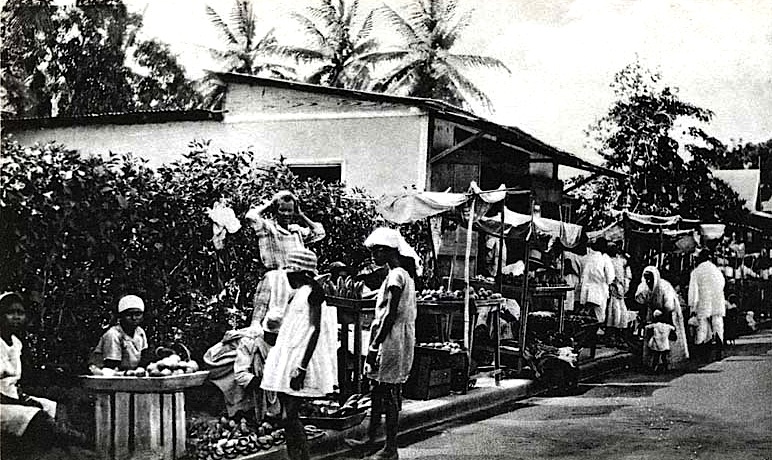By Dave DeWitt and Mary Jane Wilan
 |
Recipes:
|
Date: August, 1992
In Which We Take a B-Wee,
Lime About, Eat Congo Peppers,
Meet Shadow Bennie, and
Solve the Riddle of the Mystery Tombstone
“Two unspoiled islands, one country–Trinidad and Tobago,” pronounced Brian Kuei Tung, Minister of Trade, Industry and Tourism. Mary Jane and I were sitting in his spacious high-rise office, overlooking the Port of Spain harbor, and I was wearing long pants in honor of meeting a cabinet minister. “We don’t allow logging, so the rain forests are intact. And we don’t allow high-rise hotels to spoil our beaches.”
 |
 |
 |
 |
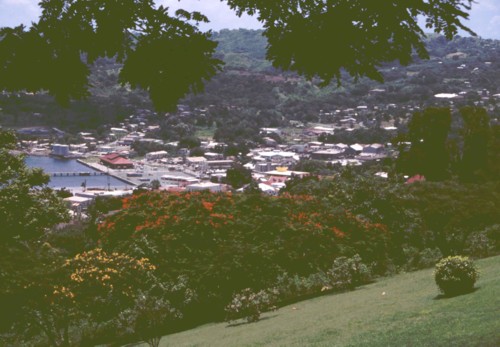 |
Say what? Was I hearing this right? A country that actually was protecting its scenic beauty and not caving in to big business and developers? Unbelievable. And even more unbelievable was the fact that we were in Trinidad.
It was all Dennis Hayes’ doing. I had met Dennis, marketing director of The Crossing Press, at the American Booksellers Association convention in Anaheim, and out of the blue he had asked one simple question.
“Dave, I’m looking for a writer for a book on the cuisine and music of Trinidad. Any suggestions?”
My mind flashed first to my extensive collection of calypso, steel drum, and soca music. Then to the framed map of the Caribbean over my desk and the location of Trinidad, just off the coast of Venezuela. Then to the face of a friend who lived in Port of Spain: Marie Permenter. And she was in the food business. Uh huh!
“Dennis, good buddy,” I said, “wouldn’t this writer have to do some research down there?”
“How soon can you leave?” he asked.
Actually, several months passed before the contract was formalized and we left for T&T, enough time for Mary Jane to agree to be a co-author and to buy some “Punch M-3” capsaicin spray (she never had to use it). Meanwhile I met various writing deadlines, did some preliminary research, and allowed Marie Pementer to plan every moment of our lives for two solid weeks. A flood of faxes from Port of Spain with appointments and schedules proved that we were headed to paradise to work, not to party. Or so we thought.
Down de Islands Via B-Wee
After island-hopping to Barbados and Grenada, our B-Wee (BWIA) flight landed at the Piarco International Airport outside of Port of Spain. My mind was asking the four most important questions of a visitor: Where do I sleep, where do I eat, how do I get around, and where do I buy beer? Fortunately, all of those questions were soon answered. We were staying at the Kapok, a friendly hotel adjacent to the beautiful Queen’s Park Savannah–a 200-acre park in the middle of the city. We were eating out twice a day, every day. Because of the narrow, streets and crazed drivers in Port of Spain, we were taking taxis everywhere. And the local favorite beer, Carib, was available at corner markets. Cheap. That was a good omen, I thought.
The first full day was Emanicipation Day and nearly everthing was closed for the holiday. But the Botanic Gardens near the Kapok were open, as as we strolled through the lush foliage, I thought: This is my kind of country. It’s summer all year long. The phones work. There are palm trees, pepper plants, the language doesn’t need constant translation, and the literacy rate of the people is ninety-seven percent.
While buying some Carib at a market a block from the Kapok, I spotted some fresh peppers that looked like gigantic habaneros. “What do you call these?” I asked the clerk and she said, “Congo peppers.” Back at the hotel, I cut them open and the pungent fumes drove Mary Jane out of the room coughing. It was the characteristic apricot aroma of the habanero.
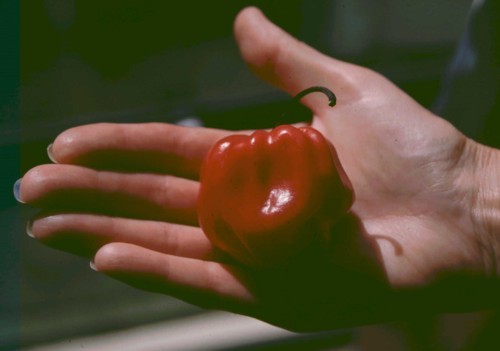
Congo Pepper in Mary Jane’s Hand
Later that afternoon I found some locally published cookbooks and brushed up on the culinary history of T&T. I soon learned that the diversity of food on the islands was the result of one wave of immigrants after another. First, the Spanish occupied Trinidad and adopted many of the foods and cooking techniques of the indigenous Arawaks. Then the Spanish invited French immigration, and the French brought with them herbs, spices, and garlic–hallmarks of T&T cookery today. Accompanying the Frenchmen were African slaves, who brought their own ingredients and cooking styles.
The British conquered Trinidad in 1797 and introduced breadfruit to feed the slaves, as well as tamarind from the East Indies. They also brought turnips and cabbage to Trinidad, two common vegetables in T&T markets today. After the abolition of slavery in 1838, more immigrants arrived to work in the sugar cane fields: the Portuguese, East Indians, and Chinese. Over the years, the immigrant foods became very popular in the country, and curries and chop suey were commonly served in homes and restaurants. Today, T&T has the most diverse cuisine of any of the Caribbean islands–and we dove into it right away with a meal of callaloo (an exquisite dasheen soup) and grilled kingfish at the Cafe Savannah.
Liming About
To “lime,” according to a local dictionary of Trini-slang, is “to pass the time in idle pleasure.” It describes every possible form of indulgence except Carnival, which is more of a frantic than an idle pleasure. Liming is hangin’ out, goofin’ off, fishin’, drivin’, swimmin’, boatin’, picnickin’, and generally just doing anything one wants to do. We were invited to lime about at a dinner party the next day at the home Marie Permenter shares with Vernon and Irene Montrichard, which overlooks a lovely bay. These three entrepreneurs founded the Royal Castle chain of spicy chicken and chips restaurants in 1968, then fought off the invasion of Kentucky Fried Chicken, and are currently setting sales records at twelve locations in T&T. Trinidadians love chicken, and they especially love Royal Castle chicken, which is marinated in a special hot sauce of congo peppers and herbs before being fried.
At the party we met the cast of characters Marie and Vernon had lined up to be our culinary guides. Mikey and Nancy Ramesar gave us lessons on East Indian cooking West Indian-style. Keith Nexar and Steve Mathura, directors of AdVantage, the advertising agency responsible for much of Royal Castle’s success, set up interviews for us and even arranged our appearance on local television. Michael Coelho, marketing director of the Royal Castle chain, was our main guide and drove us all over Trinidad.
Congo Peppers and Shadow Bennie
On our first trip, Marie and Vernon took us to their pepper fields, where the congo peppers are grown for the Royal Castle hot sauce. In Trinidad, “congo” means anything large and powerful, and these types of Capsicum chinense lived up to their name. We found some as large as lemons (see sidebar), and they had thicker walls that most of the habaneros we were familiar with. We also got a tour of their hot sauce factory.
Next, Michael located a four-wheel drive Toyota and took us on back roads that led seemingly straight up the mountains. We were on our way to see the herb growers of Paramin, who farm Spanish and French thyme, plus other herbs, on the steep slopes. Since it rains nearly every day during the wet season, the herbs love the good drainage of the steep slopes. The herbs, which are sold in markets in Port of Spain, are also an ingredient in the Royal Castle hot sauce.

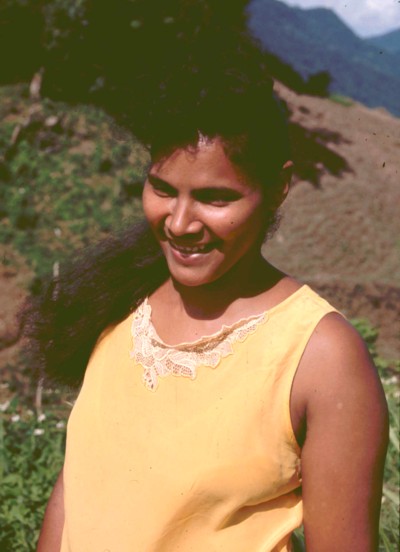
Dave and Michael Coelho in the Herb Fields; Herb Grower Kimoy Lamy
Along with Vernon and Michael’s wife, Danielle, we took a tour of the northern rain forests, with a stop along the way at Maracas Bay. That bay is the prime lime for Port of Spain, and after a cooling dip in the surf we descended on roadside stands for some shark-and-bake. This dish features fried bread stuffed with tender shark, topped with congo pepper hot sauce and another, dark green sauce they called “Shadow Bennie.” The taste was strong, flavorful, and vaguely familiar. What herb was in it, we asked. “Shadow Bennie” was all they knew.
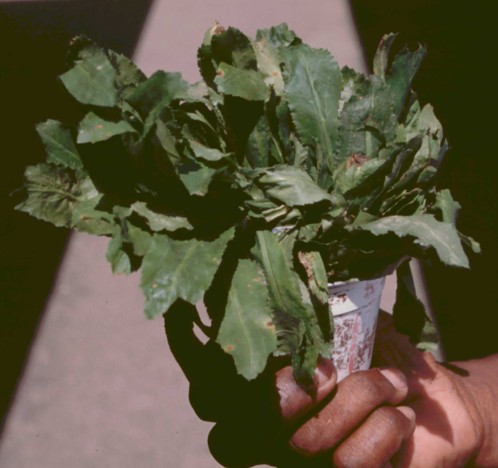
The next few days flew by. With Michael as our guide, we dove into the food of T&T. At the Patraj Roti Shop in San Juan, we tasted nine different kinds of curried fillings for the roti bread–fish, beef, chicken, goat, conch, shrimp, liver, duck, and potato. The fillings are wrapped in the bread or are served in bowls accompanied by torn up bread called Buss-Up-Shut, which is slang for “burst up shirt,” because the bread resembles torn up cloth. The curry itself was not spicy, but the congo pepper hot sauce served in squeeze bottles solved that problem.

At the Solimar Restaurant adjacent to the Hotel Normandie, strapping, trouble-shooting chef Joe Brown told us about his exile as executive chef at a Korean hotel because of a misunderstanding in a bar. He looked perfectly happy running in own place in Port of Spain, and has launched a one-man crusade to teach Trinidadians about fine wine. I had Joe’s delicious mixed seafood grill, MJ tried the Tandoori chicken, and we desserted out on the unlikely-sounding but wonderful avocado and pistachio ice cream.
Then it was time to go native. Michael turned us over to his friend, Johnny Nahous. Johnny, who is of Lebanese descent, owns Johnny’s Food Haven, a restaurant which serves “native” food, or Creole food as it’s called there. On a typical day he serves stewed oxtail, curried crab and dumplings, callaloo, chicken pelau, Chinese marinated chicken, cowheel soup, sauteen cassava, and at least four additional entrees. He has to have that many–on Fridays, Johnny sells five hundred lunches.
Johnny took us on a tour of the bustling Central Market, where if you’re not careful, you can get run over by a barrow full of cabbages. Vendors raised their prices when they saw the foreigners with him, but Johnny waved them off in disgust and pursued the bargains. The multiple displays of congo peppers were very impressive, being the most habaneros I had even seen in one place.
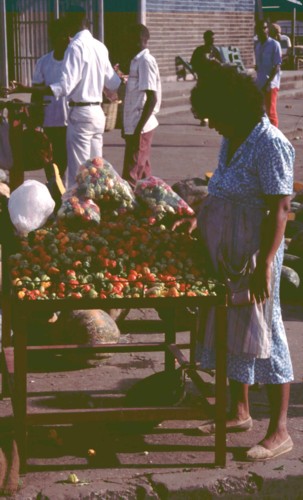
Pepper Vendor
Decoding The Mystery Tombstone
In order to get a feel for the entire country, we took the twelve minute flight from Trinidad to Tobago. In the tiny airport, we were accosted by dozens of cabbies and providentially picked a distinguished looking man named Basil Phillips. As luck would have it, Basil’s brother, Reginald, was the technical officer at the Tobago Botanic Station, so after a brief tour of Scarborough, we dropped in on Reginald, who gave us an interesting interview about growing peppers between rows of papaya, and then showed us his congo pepper seedlings, which the station sold to farmers for a dollar a flat. That’s twenty cents, U.S.
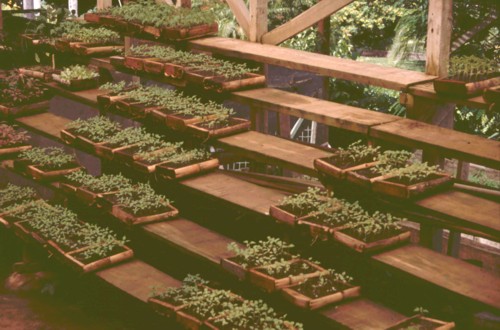
Congo Pepper Seedlings
After lunch at the open-air Blue Crab restaurant (I had kingfish again; MJ had the fried flying fish), Basil invited me along on his next agouti hunt and then gave us a simple lecture on the difference between Trinidad and Tobago: “Speed. Everyt’ing runs slower in Tobago.” It was true. Basil drove half the speed of the drivers in Trinidad.
At the Scarborough market, I asked Basil: “You ever heard of Shadow Bennie?”
“Shore, mon,” he answered. “Right there.”
He pointed to a vendor’s stand and a bunch of culantro (Eryngium foetidum), the native American herb that tastes like a stonger version of cilantro. So much for the Shadow Bennie mystery.
But another, more difficult mystery loomed ahead. In the little village of Plymouth, Basil showed us the “mystery tombstone,” which has the a riddle inscribed upon it that supposedly has never been solved. The inscription on the eighteen century tombstone of one Betty Stiven reads: “Was a mother without knowing it, and a wife without letting her husband know it, except by her kind indulgence to him.”
Now this riddle baffled us for a while, after a beer at the airport, we figured the whole thing out. Betty Stiven meets this guy and falls in love with him. But he refuses to marry her and she won’t live in sin, so she gets him so drunk he passes out and a preacher with a good sense of humor marries them. Betty, being a wife without his knowledge, kindly indulges his every whim, and the result of one of those whims is that Betty becomes pregnant. But before she realizes she is pregnant, she is struck down by brain fever and goes into a coma. Without regaining consciousness, poor Betty comes to term and delivers a baby boy, but she dies during birth, “a mother without knowing it.” So much for that riddle! Hope this revelation doesn’t ruin Tobago’s tourist industry.
Before we left T&T, we went down de islands again, this time on Vernon’s boat to visit the resort islands between Trinidad and Venezuela. Later, we ate at more restaurants, including a great meal Middle Eastern meal at the Ali Baba, and visited the pan yards, where the steel drum bands were practicing for the upcoming Steelband Music Festival. And speaking of steel bands, even in August, six months before the festivities, much of the talk in T&T was about Carnival, and how we hadn’t really seen T&T unless we were there during the extravaganza of fetes, parades, masquerades, and calypso contests. After all, Trinidadian Peter Minshall had just designed the opening ceremony for the Olympics, our hosts reminded us, so imagine what he could do at Carnival!
We’ll just have to go back–after we get the book written. Meanwhile, we collected dozens and dozens of recipes for our forthcoming book. Following are some of our favorites from various cooks we met.
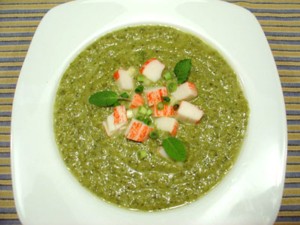
Callaloo, Calypso, and Carnival: The Cuisines of Trinidad and Tobago, by Dave DeWitt and Mary Jane Wilan, was published by The Crossing Press in Spring, 1993.
Congo Peppers for Sale
Trinis love their hot peppers, which are a pod type of the species Capsicum chinense, locally called “congo peppers” or simply “hot pepper.” Similar peppers of this species are called “habanero” and “Scotch bonnet” in other parts of the Caribbean. A milder pepper called “pimento” or “seasoning pepper” is also grown, as are bell peppers, but most of the acreage in T&T is devoted to the congo pepper. The plants grow two to three feet high in a single year and are picked twice. Then they are plowed off and the site is replanted. The growers say that the plants would live for decades, but would produce smaller fruits each year.
Nobody seemed to know exactly how many acres were in pepper production in T&T, but after talking to a few knowledgable people close to growers, like Vernon Montrichard, the figure of 2,000 acres seemed to be the best estimate. Much of this crop is exported. Total exports to Canada, the U.S., and the U.K. amounted to TT$ 1.6 million in 1991, with about 131 tons alone exported to the U.S.
Trinidad growers are interested in finding importers in the United States. Interested parties should write to this magazine and we will forward requests to the Trinidad and Tobago Export Development Corporation.
Tiki Village Congo Pepper Sauce
At our first lunch in T&T, Diana Cohen-Chan, manager of the Kapok Hotel, treated us to a dim sum feast at her top-floor restaurant. It was dim sum with a difference as Ramesh Ghany (a chef of East Indian descent cooking at a Chinese restaurant) told us how he makes his simple Creole congo pepper sauce. Now, Ramesh uses 300 congo peppers to make a gallon of sauce, so we’ve scaled the recipe down to more modest dimensions.
3/4 cup vegetable oil
20 large Congo peppers (habaneros), seeded and minced extremely fine; or, puree in a food processor
Bring the oil to a boil, add the minced congo peppers, and turn off the heat. Allow to sit for at least a half-hour.
Yield: 1 cup
Heat Scale: Off the register; use sparingly!
Johnny’s Food Haven Pepper Sauce
The motto at Johnny’ Food Haven is “Trinidad home cooking away from home.” Johnny serves his food cafeteria-style–one of only two or three restaurants to do so in Trinidad. Ladies take note: Johhny is thirty-one years old, single, and an expert cook.
5 Congo peppers (habaneros)) or as many as can be stuffed into 1 cup
1 cup water
1/2 teaspoon salt
1 onion, minced
2 cloves garlic, minced
1/4 cup shadow bennie (culantro) or substitute cilantro, minced
Puree the peppers with the water in a blender. Add the remaining ingredients and let the mixture sit for at least an hour to blend the flavors. Serve with grilled meats, poultry, or fish.
Variation: Add cooked pumpkin or carrots to make the sauce milder.
Yield: 2 cups
Heat Scale: Extremely hot
Callaloo

This remarkable, bright green soup is often called “the national dish of T&T.” As prepared by chefs Keith Toby and Irvine Jackson of the Cafe Savannah, usually features callaloo (taro leaves or dasheen), but spinach is an excellent substitute. Use coconut milk, not the canned, sickly-sweet coconut cream used in drinks.
3 bundles callaloo or 3 bunches fresh spinach, washed, tough ribs removed, coarsely chopped
4 cups coconut milk (made by soaking 4 cups grated coconut in 4 cups of hot water for 1/2 hour, then straining it)
2 cups milk
2 cloves garlic, minced
2 medium onions, chopped
1 bunch scallions, chopped
1/4 pound pumpkin or Hubbard squash, peeled and coarsely chopped
1/4 pound butter
Salt and pepper to taste
Habanero hot sauce to taste
In a stockpot or soup pot, combine all the ingredients and boil for 4 minutes. Reduce the heat and simmer for 40 minutes. If too thick, add more milk. Remove from the heat, cool, and puree in a blender in small batches. Reheat the soup and serve.
Variation: add 2 cups of cooked crab meat to the finished callaloo.
Yield: 8 to 10 servings
Heat Scale: Varies
Royal Castle Fried Chicken
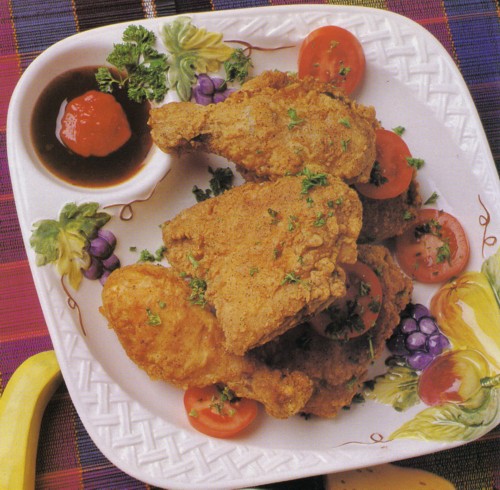 Photo: Chel Beeson
Photo: Chel Beeson
This marinated chicken is available all over Trinidad at the Royal Castle restaurants, and we’ve duplicated here for people not able to visit Trinidad. Marie Permenter serves it with a sweet coleslaw and french fries (called “chips,” of course). We munched on it while driving all over Trinidad.
1 chicken, cut up into 6 pieces
1 bottle Trinidad habanero Sauce (available at gourmet shops and by mail order), or more to taste
2 tablespoons water
1 egg, beaten
Flour for dredging
Oil for frying (soy or canola)
Arrange the chicken in a glass baking dish and pour the sauce over it. Sprinkle the water over the top and marinate the chicken overnight in the refrigerator.
Remove the chicken from the marinade and let in drain in a colander. Dip the pieces in the egg and then place them in a large plastic bag filled with the flour. Shake the bag to coat all the pieces, and then fry them in the oil, saving the breasts until last since they will take less time. The legs and thighs will take about 8 minutes per side. Do not crowd the chicken, and fry it in two batches if necessary.
Drain the chicken on paper towels and serve immediately with additional habanero Sauce.
Yield: 3 to 4 servings
Heat Scale: Medium
Ramesar Curried Mango

This recipe is from our cooking lesson with Nancy Ramesar. She includes the mango seed as part of the recipe because, as she says, it’s great to pick it up and suck the flavor off it. Nancy uses the famous Chief brand Amchar Massala, but a good substitute is to roast 6 tablespoons of coriander seeds, 1 teaspoon of fenugreek seeds, 2 teaspoons of fennel seeds, 1 teaspoon of mustard seeds, and 1 1/2 teaspoons of cumin seeds, and grind them all together.
4 green mangos, only about half-ripe
2 tablespoons vegetable oil
1 cup water
2 cloves garlic, mashed
2 tablespoons Amchar Massala or commercial curry powder
Scrub the mangoes thoroughly, leave the skins on, and cut into 2-inch slices, leaving some mango meat on the seeds.
Heat the oil in a large, heavy casserole. Add the mashed garlic cloves, water, and the massala and cook for 2 to 3 minutes on medium heat.
Add the mangoes and stir to coat them with the mixture. Reduce the heat, cover, and simmer until tender, about 30 to 40 minutes.
Check the mixture about halfway through the cooking and add more water if it is dry. Taste the mixture when it’s done and if it’s too sour, add 1 teaspoon of sugar.
Yield: 6 to 8 servings as a side dish.





